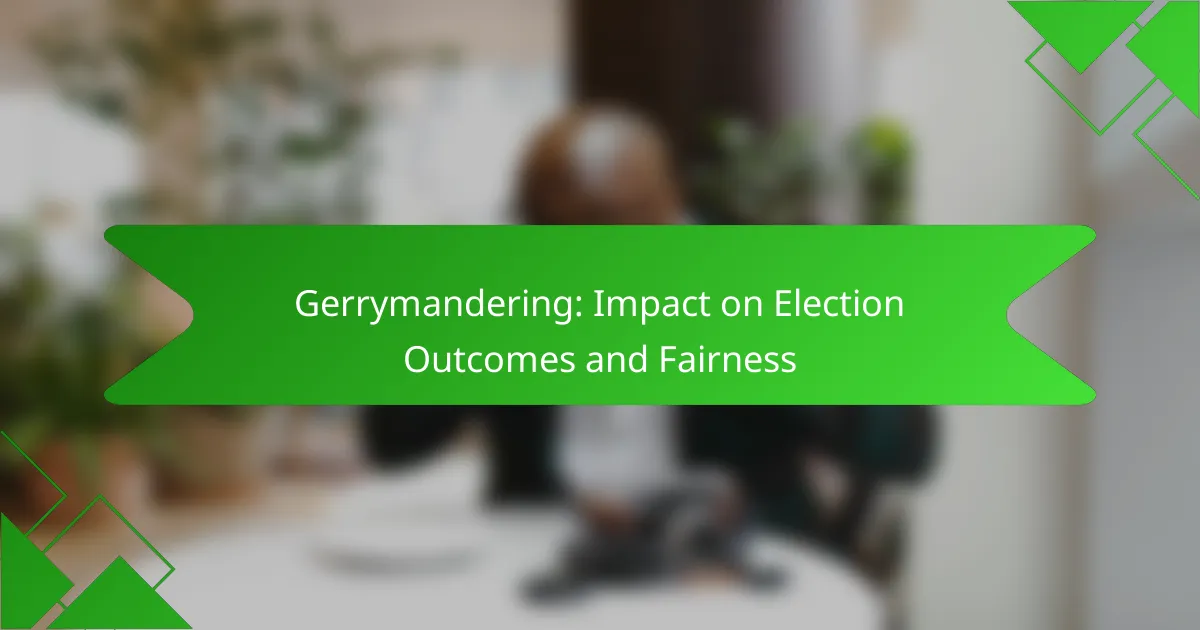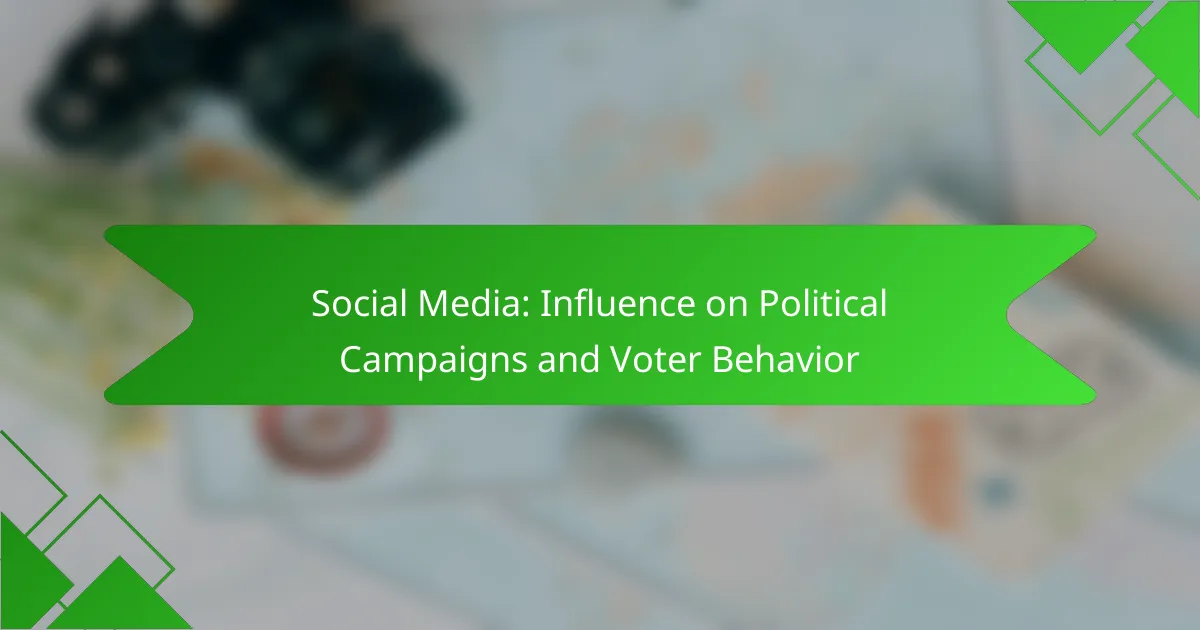Voter turnout among Millennials has seen a notable increase in recent years, reflecting a growing commitment to civic engagement within this demographic. Defined as individuals born from the early 1980s to the early 2000s, Millennials are leveraging their unique strengths to mobilize peers and communities, thereby enhancing participation in the electoral process. Factors such as access to information and political awareness play crucial roles in shaping their engagement and can help identify both barriers and opportunities for further increasing voter turnout.
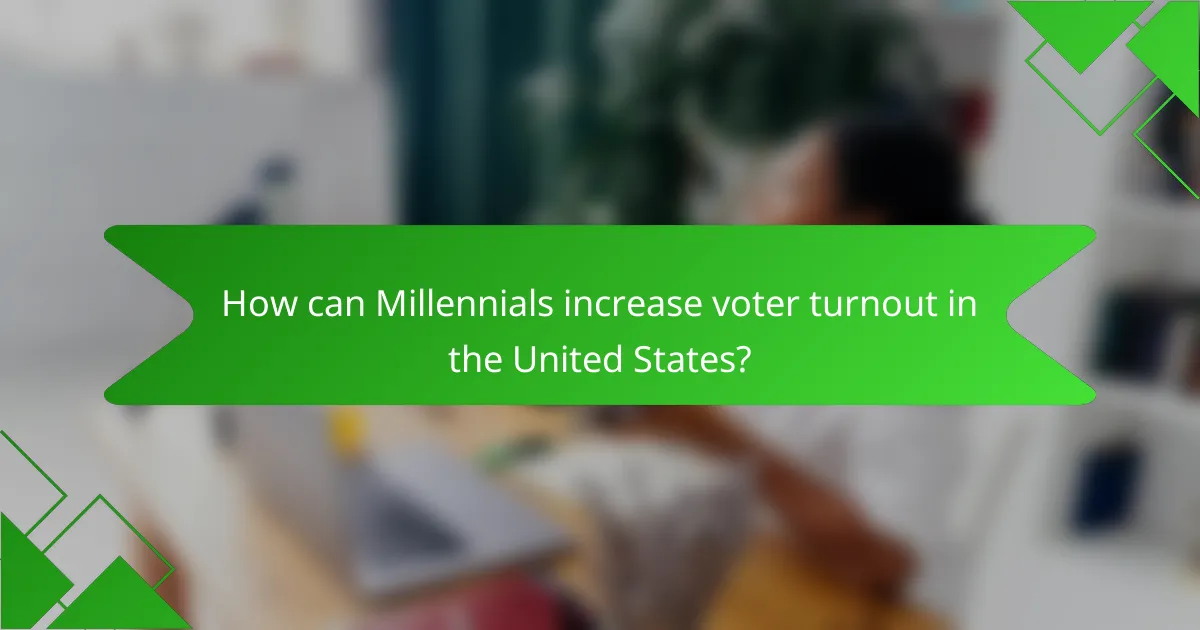
How can Millennials increase voter turnout in the United States?
Millennials can increase voter turnout in the United States by actively participating in campaigns that promote engagement and awareness. By leveraging their unique strengths and platforms, they can mobilize their peers and communities to vote.
Utilizing social media campaigns
Social media platforms are powerful tools for Millennials to increase voter turnout. By creating engaging content that resonates with their peers, they can spread awareness about upcoming elections, registration deadlines, and voting procedures.
Effective campaigns often include eye-catching graphics, informative videos, and interactive posts that encourage sharing. Collaborating with influencers can amplify these messages, reaching a broader audience and fostering a sense of urgency around voting.
Engaging through community events
Organizing community events is another effective strategy for boosting voter turnout among Millennials. These events can range from informal gatherings to larger rallies that educate attendees about the voting process and issues at stake.
Incorporating fun elements, such as live music or food trucks, can attract more participants. Additionally, providing resources like voter registration booths or informational sessions can empower attendees to take action and vote.
Leveraging peer influence
Peer influence plays a significant role in motivating Millennials to vote. Encouraging friends and family to participate in the electoral process can create a ripple effect, leading to higher turnout rates.
Simple actions, such as sharing personal voting experiences or discussing the importance of specific issues, can inspire others. Creating group plans to vote together can also enhance accountability and make the voting experience more enjoyable.

What are the current voter turnout trends among Millennials?
Millennials are increasingly participating in elections, with voter turnout rates rising significantly in recent years. This demographic, generally defined as those born between the early 1980s and the mid-1990s to early 2000s, is becoming more engaged in the political process, reflecting a shift in attitudes toward civic responsibility.
Increased participation in recent elections
In the last few election cycles, Millennials have shown a marked increase in voter turnout, often reaching participation rates that rival older generations. For instance, during the 2020 U.S. presidential election, turnout among Millennials was estimated to be around 50%, a significant jump from previous years. This trend indicates a growing commitment to voting and political engagement among younger voters.
Factors contributing to this rise include heightened awareness of social issues, the influence of social media, and targeted outreach efforts by various organizations. Many Millennials are motivated by issues such as climate change, racial equality, and economic opportunity, which resonate with their values and priorities.
Comparison to previous generations
When compared to previous generations, Millennials exhibit different voting behaviors and motivations. For example, Baby Boomers and Generation X typically had higher turnout rates in their early voting years, but Millennials are catching up as they age. The gap in participation is narrowing, particularly as Millennials become more established in their careers and communities.
Moreover, Millennials tend to prioritize issues over party affiliation, which can influence their voting patterns. This generation is more likely to support candidates who align with their values, regardless of traditional party lines, reflecting a shift in political engagement strategies across generations.
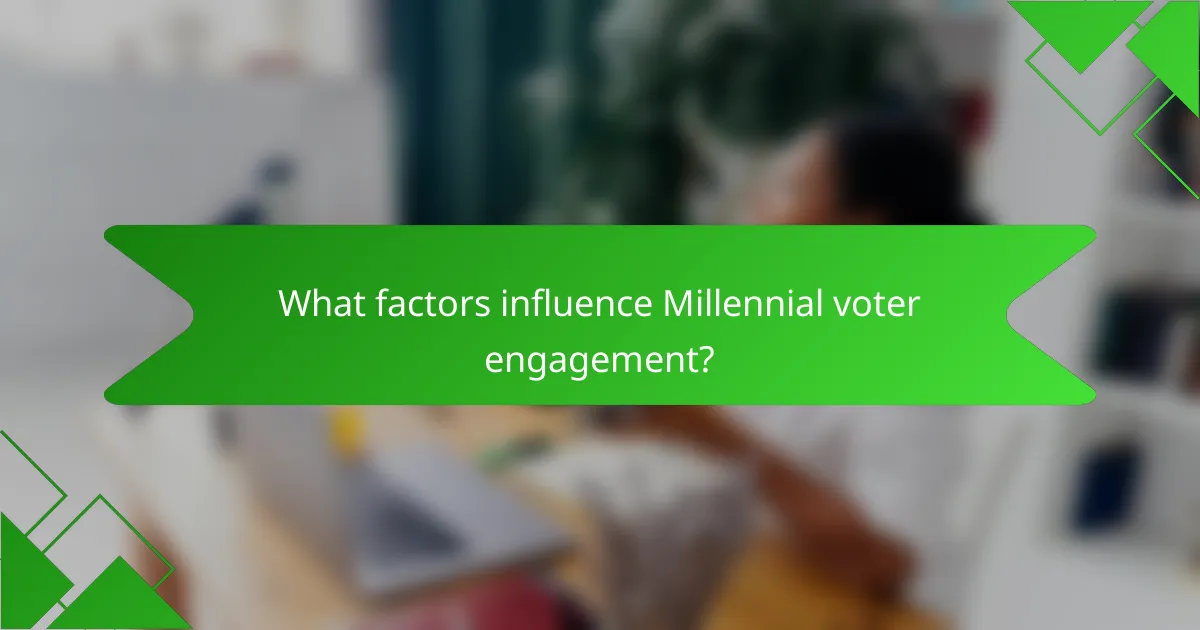
What factors influence Millennial voter engagement?
Millennial voter engagement is influenced by several key factors, including access to information, socioeconomic status, and political awareness and education. Understanding these elements can help identify barriers and opportunities for increasing participation among this demographic.
Access to information
Access to information plays a crucial role in Millennial voter engagement. With the rise of digital media, Millennials often rely on social media platforms and online news sources for political information, which can be both beneficial and misleading.
To enhance engagement, it is essential for Millennials to seek credible sources and verify information before forming opinions. Engaging with non-partisan organizations that provide clear, unbiased information about candidates and issues can also be helpful.
Socioeconomic status
Socioeconomic status significantly impacts Millennial voter participation. Those with higher incomes and education levels tend to vote at higher rates compared to their lower-income counterparts. Economic stability often correlates with a greater sense of civic responsibility and the ability to take time off work to vote.
Efforts to increase engagement among lower-income Millennials can include initiatives that provide resources for understanding voting rights and facilitating access to polling places, such as transportation assistance or flexible work hours on election days.
Political awareness and education
Political awareness and education are vital for fostering Millennial voter engagement. Many Millennials express a desire for more comprehensive education on political processes and the importance of voting. Programs that focus on civic education in schools and community organizations can help bridge this gap.
Encouraging discussions about current events and political issues among peers can also enhance awareness. Millennials should be encouraged to participate in local forums or workshops that promote understanding of the electoral process and the impact of their votes.
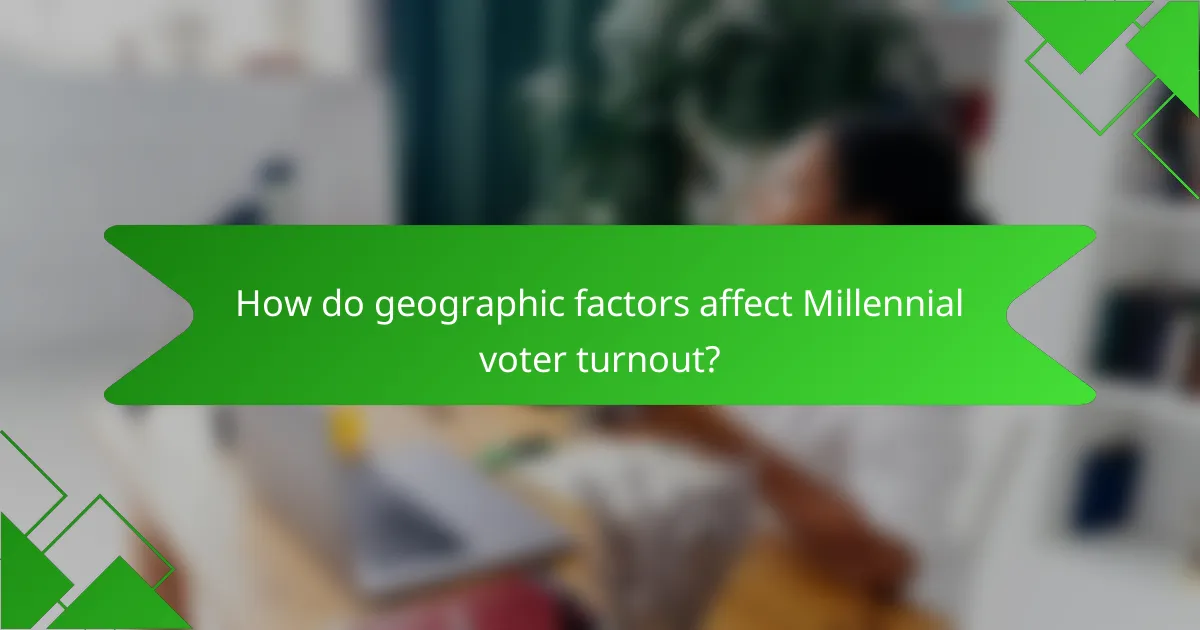
How do geographic factors affect Millennial voter turnout?
Geographic factors significantly influence Millennial voter turnout, with variations in urban and rural settings, as well as state-specific voting laws playing crucial roles. Understanding these factors can help identify barriers and opportunities for increasing participation among this demographic.
Urban vs. rural participation rates
Millennials in urban areas tend to have higher voter turnout rates compared to their rural counterparts. This difference can be attributed to factors such as greater access to polling places, more robust civic engagement initiatives, and a higher concentration of organizations promoting voter participation.
In rural regions, challenges like limited transportation options and fewer polling locations can hinder participation. Additionally, Millennials in these areas may feel less connected to the political process, which can further decrease turnout rates.
State-specific voting laws
Voting laws vary significantly by state, impacting Millennial voter turnout. States with more accessible voting options, such as same-day registration and mail-in ballots, generally see higher participation rates among young voters. For example, states like California and Colorado have implemented measures that facilitate easier voting, which can boost turnout.
Conversely, states with stricter voting laws, such as voter ID requirements or limited early voting periods, may discourage Millennials from participating. Understanding the specific regulations in their state can empower young voters to navigate the voting process more effectively.

What role do political parties play in Millennial engagement?
Political parties significantly influence Millennial engagement by shaping their perceptions and motivations to participate in elections. Effective strategies can enhance connection and drive turnout among this demographic, which is crucial for fostering a vibrant democratic process.
Party outreach strategies
Political parties often employ targeted outreach strategies to engage Millennials, utilizing social media platforms and digital campaigns to reach this tech-savvy group. These strategies may include interactive content, online forums, and personalized messaging that resonate with their values and concerns.
Additionally, parties can organize events that encourage participation, such as town halls or community service projects, which help build a sense of belonging and investment in the political process. Engaging with local issues and showcasing relatable candidates can further enhance outreach effectiveness.
Candidate relatability
Millennials are more likely to engage with candidates who reflect their experiences and challenges. Candidates who share similar backgrounds, values, or life experiences can foster a deeper connection, making Millennials feel that their voices are represented. This relatability can be a decisive factor in voter turnout.
Moreover, candidates who actively listen to Millennial concerns, such as climate change, education reform, and social justice, can create a strong rapport. By addressing these issues in their platforms and communications, candidates can motivate Millennials to participate in elections and advocate for change.

How does technology impact voter participation?
Technology significantly enhances voter participation by simplifying processes and increasing accessibility. Online tools and mobile applications make it easier for individuals, particularly younger voters, to engage with the electoral process.
Online voter registration tools
Online voter registration tools streamline the process of registering to vote, allowing users to complete their registration from home. Many states in the U.S. offer these services, which can reduce registration time to just a few minutes.
These platforms often require basic information such as name, address, and date of birth. Users should ensure they have valid identification, as some states may require it for online registration. It’s crucial to check state-specific deadlines to avoid missing the registration window.
Mobile voting applications
Mobile voting applications are emerging as a way to facilitate voting, especially for those unable to vote in person. These apps can provide information on polling locations, ballot details, and even allow for remote voting in certain jurisdictions.
While mobile voting can increase participation, it raises concerns about security and accessibility. Voters should verify that their state supports mobile voting and that the app complies with local regulations to ensure their votes are secure and counted accurately.







